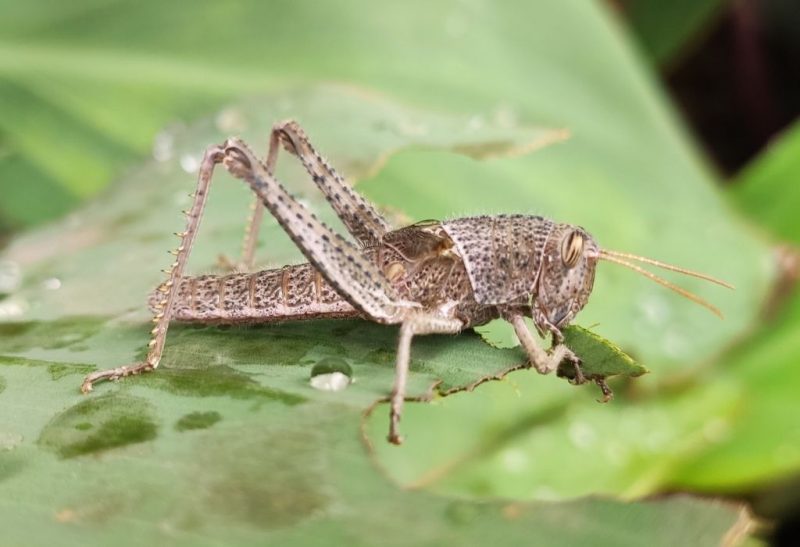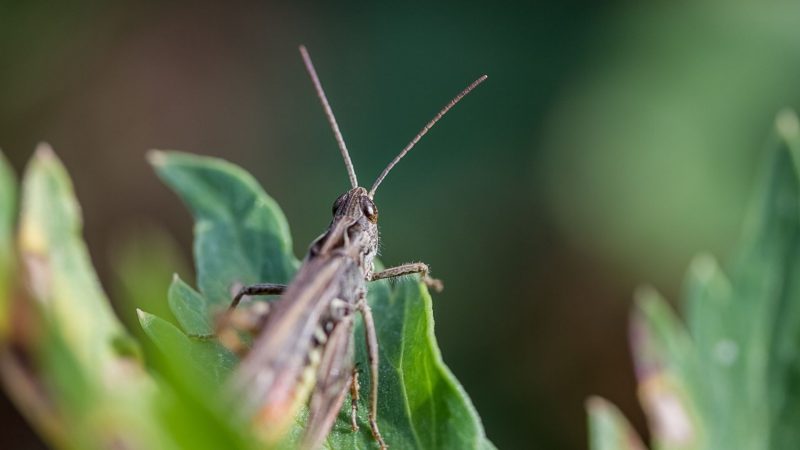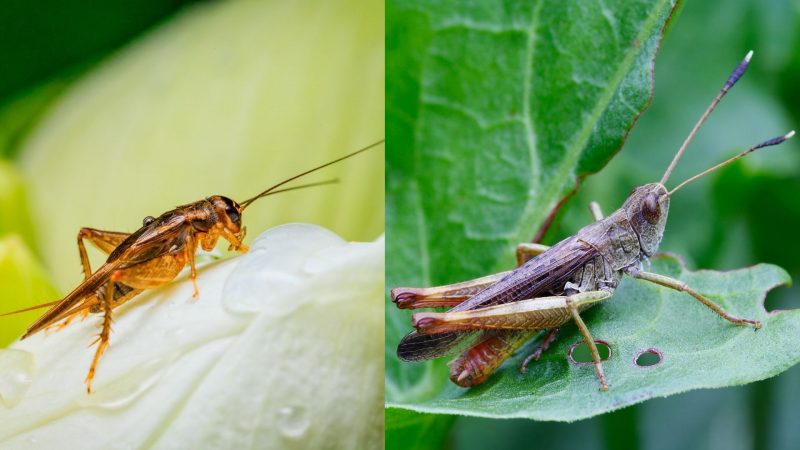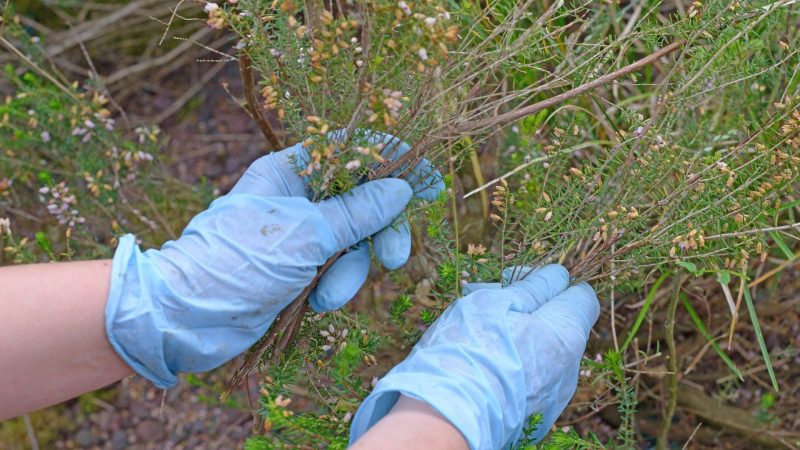For the longest time, crickets have been part of our night meditation. The chirping sound they create from the rubbing of their wings is like a sweet lullaby that calms our senses and puts us to sleep. They are nocturnal animals and are often up all night just to mate and look for food. But what do they eat? What gives them the energy to produce that chirping sound all night?
What do crickets eat? Crickets are an omnivorous animal. Accordingly, a natural cricket diet comprises of plants, meat, cereals, and produce in addition to protein. Crickets have a diverse food in the environment, which includes insect larvae, aphids, flowers, seeds, leaves, fruit, and grasses.
This article will let you know what food keeps the crickets up at night, and understand these insects more by knowing their behavior, activities, different breeds, and the excellent ways to get rid of them.
Different Types of Crickets | Identification, and Diet
The following are the different types of crickets, their identifying traits, and their diet:
| TYPE OF CRICKET | IDENTIFYING TRAITS | DIET |
| Camel Crickets | They are large in size and weight and appear like katydids or long-horned grasshoppers. These crickets have spiny hind legs but have no wings. | Plants, roots, fruits, insects, fungi, and fabric. |
| Field Crickets | Adult field crickets are usually 1 inch long and dark brown to black in color. They have well-developed wing structures and long hind legs, which they use for jumping. The immature field crickets are similar in appearance but have no wings. | Plants such as ragweed, crabgrass, and chicory, dried organic supplies, small fruits and seeds, and living and dead small insects. |
| Weta Crickets | They are large in size and weight and appear like katydid or long-horned grasshoppers. These crickets have spiny hind legs but have no wings. | Plants, living and dead insects, other crickets, fabrics, and clothing made from wool, silk, cotton, and synthetic textiles. They are also attracted to soiled clothes. |
| White-Kneed Crickets | They can be as long as 2 inches in length with a weight as heavy as 10 grams. Their hind legs are very extended, and their knees have white to yellowish patches. | Nuts, leaves, fruits, and dead animals. |
| Giant Crickets | They are almost 2 inches in length and have light brown to grayish hues. These types have small pointed spikes at their legs and thorax and have large, sharp jaws. | Plants and vegetables and dead insects. |
| Mormon Crickets | They can be as long as 3 inches and may appear in a variety of colors like brown, black, green, purple, and red. Their shields have colored markings, and their abdomens have striations. | Grains, crops, small insects, grasses, forbs, shrubs, and fruit trees. |
| Jerusalem Crickets | Their length may be up to 2 inches, and their bodies’ color may be yellowish to brown. They have big heads, but when you look at them frontally, their faces appear smaller. | Roots, tubers, leaves, small ants, and other crickets. |
| House Crickets | They typically measure 0.63 to 0.83 inches in length and are brownish to gray in color. The male and female species appear similar, but the latter have brown to black ovipositors while the former have prominent cerci. | They can develop up to 1.2 inches long with a body color ranging from brown to black. Australian field crickets have extended antennae and legs, which they use for jumping. |
| Parktown Prawn or King Crickets | Parktown prawns are 2- 3 inches in length and have orange to light brown bodies. They have long antennae, and their abdomens are filled with brown to black stripes. | Plants, fallen fruits, snails, slugs, moth larvae, dead birds, and pet feces. |
| Roesel’s Bush Cricket | The length of their bodies is 0.5 to 1.5 inches, while the color of their bodies is yellow to brown, although some have greenish hues. They also have yellow to green spots on their abdomen. | Grass seeds, meadows, tall grass swards, and small insects. |
| Australian Field Cricket | They can develop up to 1.2 inches long with a body-color ranging from brown to black. Australian field crickets have extended antennae and legs, which they use for jumping. | Cereal and pasture seed crops, soybean, sunflower, and other plant matters. |
How Long Do Crickets Live?
If its requirements are completely met in captivity, the average cricket only survives 8 to 10 weeks. Positively, if you provide them with all they require and give them a suitable cage, they will keep laying eggs and you will have an infinite supply of crickets.
How Often Do Crickets Eat?
Crickets typically eat as much as they need to as long as there is food nearby.
Crickets go through a process known as “diapause” when exposed to extreme weather, such as the chilly winter months. The crickets’ bodies turn off their biological functions and stop growing under such circumstances. The rate of feeding is reduced to practically zero under these circumstances.
What Do Crickets Eat?

Since crickets are omnivorous in nature, they eat plants such as grains, fruits, and vegetables and animals like small insects and meat of dead faunas.
If you plan on nurturing crickets for the purpose of feeding your pet reptiles, it is important to provide these insects with healthy and nutritious food. Provisions like apples, oranges, carrots, leafy vegetables, and grains can be a good source of nutrients for crickets. Also, feeding them pet food or providing them with a commercial cricket diet can promote their optimum nutrition and wellness.
What Do Crickets Like to Eat?
Crickets consume a vast range of meals, and the type of food they consume varies by species. There are approximately 100 different species of cricket in the United States alone out of the more than 900 that exist worldwide.
Some bugs consume both plant and animal, making them omnivores. Others eat primarily plants because they are herbivores. Some crickets, however, are predators that survive primarily on other insects and animals.
In addition, some crickets take on the role as scavengers, mostly consuming any organic matter that is rotting. Additionally, the diets of wild and caged crickets are very dissimilar.
The things that crickets typically consume include the following:
- Flowers
- Fruit
- Leaves
- Grass
- Larvae
- Insects
- Aphids
- Seeds
- Decaying matter
- Fungi
What Do Crickets Eat in the Wild?
Crickets consume a number of different meals in the wild. According to the species, environment, and season, they have different diets.
Crickets that are herbivorous generally consume plants like grasses, fruits, and flowers. They will also consume immature plant shoots, seeds, and seedlings. Contrarily, carnivorous crickets primarily consume other animals. Smaller insects, as well as pupae and larvae, will be their primary targets. Aphids in particular are a favored food of crickets.
Crickets will devour a lot of these little sap-sucking insects because they enjoy going after them. Invertebrate eggs from other species are also part of their diet. While this is happening, omnivorous insects consume both plant and animal.
However, scavenging insects favor organic matter that is already dead or is in the process of degradation. They’ll hunt for items like fungi, dead plants, carcass, and seedlings. But even so, crickets will consume nearly anything they can.
What Do Captive Crickets Eat?
Crickets are a popular choice for pet owners. While some raise them as amusement, others do so as food for other creatures including insects. You’ll need to understand what to feed crickets in order to keep them healthy if you are considering keeping them as your pets.
Crickets, however, are extremely adaptable creatures. They may learn to eat almost anything in order to stay alive if they are raised in captivity. The majority of species have adapted to thriving on a diet of pet food, like dog kibble, in captivity. However, these insects typically eat aphids as well as fresh vegetables like lettuce.
In addition to eating vegetables like potatoes, carrots, and greens, herbivorous crickets may survive on a diet of fruits like apples, oranges, and bananas. Aphids, ants, ladybugs, and other tiny insects will be necessary for carnivorous crickets to survive. Learning what your pet cricket requires for survival is the most important thing.
What Do Baby Crickets Eat?
Nymphs, often known as baby crickets, are the young stages of a cricket’s life cycle. The majority of crickets live around half of their lives as nymphs after hatching from an egg.
A cricket usually stays for 6 weeks as a nymph and the same amount of time as an adult. Nymphs consume an extensive variety of foods in the wild. They consume a greater variety of meals than adult crickets.
Nymphs consume a variety of foods, including invasive plants, grasses, seedlings, grains, fruits, and other insects. They can be a menace for agricultural harvests when gathered in high quantities because of how they consume food. Due of this, many farmers and gardeners now consider crickets to be pests.
How Do Crickets Hunt and Forage For Food?
Crickets have sharp vision. They can focus on multiple images at once thanks to their enormous compound eyes. They can locate food and follow moving prey owing to their acute vision.
Additionally, crickets have a good sense of smell. They can locate food by using their antenna to detect pheromones and other aromas. They are able to hear noises and feel vibrations in the surfaces around them because to the tympana in their legs.
Additionally, although less sophisticated than those in our mouths, insects have taste buds in their lips. Last but not least, microscopic hairs cover the bodies of crickets. They can gather information from their surroundings thanks to these hairs, which serve as touch receptors.
Should I Give Water To My Crickets?
Crickets require a constant supply of clean water despite the fact that they can obtain some of their water needs from fruits and vegetables. Otherwise, they risk dehydration and death.
Crickets tend to drown in a bowl of water due to their poor swimming abilities and lack of strength or size. As a result, you can offer water in the structure of a cotton ball that has been wet. If a water bowl is still what you would like, ensure that it is small in size.
Can Crickets Bite?

Crickets have the ability to bite but only in rare circumstances. They seldom reach the human skin to puncture and make breaks on it. But when they do, various illnesses may be acquired by the host due to their ability to carry parasites such as salmonella and E. coli. Once these microorganisms are introduced into the bloodstream, any person bitten by affected crickets is at high risk for acquiring infection.
Are Crickets Nocturnal?
Crickets are known to be nocturnal creatures. They sleep during the day and spend their evenings looking for partners to mate and food to eat. This is also one of the reasons why they are overly attracted to lights.
How Do Crickets Make Noise?
Crickets are very popular for their chirping noises at night. It is produced when they rub their wings together or by rubbing their legs on their wings in some cases. It signals their desire to call and look for partners in order to perform the act of mating.
How Do Crickets Get in the House?
Since crickets are entertained by lights, they would usually hop on areas where there is bright and heavy lighting. Once they spot these areas, they would look for ways to go near them.
This could be through door openings, open windows, or holes and cracks in the house where they can conveniently enter. Therefore, it is advisable to replace your outdoor lights with a yellow one and repair the openings that can facilitate their entrance.
What Is the Difference Between a Cricket and a Grasshopper?

Crickets can be distinguished from grasshoppers in the following manner:
- As to size: Crickets are generally smaller than grasshoppers. The former measures 0.1 to almost 2 inches, while the latter usually has a length of 2 to 3 inches.
- As to color: Crickets are brown or black, while grasshoppers are typically green. However, the latter may also come in other colors such as red, blue, and pink.
- As to the sound produced: Crickets rub their wings together in order to make a chirping sound while the grasshoppers rub their legs against their wings in order to create a flapping noise.
- As to diet: Crickets are largely omnivorous as they eat both plants and animals, while the majority of grasshoppers are herbivores and like to feed on grasses, green leaves, flowers, and plant stems.
- As to when active: Crickets are more active at night as they are nocturnal insects, while grasshoppers are active during the day.
- As to where they lay their eggs: Female crickets inject their eggs into the soil and plant stems while grasshoppers usually lay their eggs on the ground.
Related: Are Crickets and Grasshoppers Related in Any Way? | All You Need to Know!
How to Get Rid of Crickets?

These are the effective ways of getting rid of crickets:
1. Prevent the entry of crickets by employing the following strategies:
- Trim and cut the weeds and grasses that are found near the foundations of your house.
- Repair the cracks, holes, and crevices in doors, windows, and other areas where the crickets could enter.
- Lessen the lighting in your outdoor areas and replace white, neon, and mercury vapor lights with yellow.
- Eliminate bushes, shrubs, firewood, and other debris and objects near the house.
2. Use insecticides to get rid of crickets and their eggs and larvae.
- These products usually contain permethrin β-cyfluthrin or deltamethrin which are very potent in exterminating pests. It is typically sprayed and applied around the house and near the structural foundation for better effect.
3. Maintain the order and cleanliness of your house by doing the following techniques:
- Keep the damp areas around your house dry.
- Clean and arrange boxes, papers, and belongings in such a way that these crickets would not have a hiding spot.
- Declutter and throw away unnecessary materials and supplies.
Related: Home Remedies for Cricket Control: How To Get Rid of Crickets Naturally?
List of Sources
Grillons, True Crickets, Grillen. University of Michigan.
Hahn, J., Ascerno, M. (2018). Crickets. University of Minnesota.
House-Invading Crickets. University of Missouri.
- Bed Bug Surge 2025: How to Detect, Prevent, and Safely Eliminate Infestations in Top U.S. Cities - June 18, 2025
- Asian Needle Ants Invade US Homes: 2025 Guide to Identification, Risks, and Effective Control - June 11, 2025
- New World Screwworm Alert: How US Livestock Owners Can Prevent Outbreaks and Protect Herds [Summer 2025 Update] - June 8, 2025
